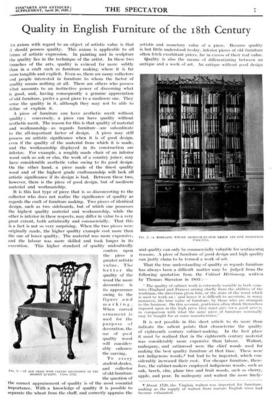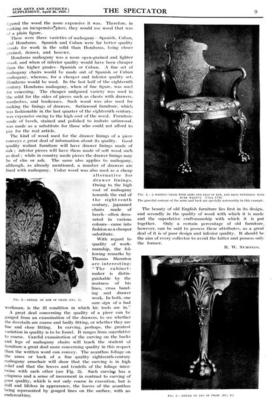Quality in English Furniture of the i8th Century
AN axiom with regard to an object of artistic value is that it should possess quality. This axiom is applicable to all forms of artistic expression. In painting and in sculpture the quality lies in the technique of the artist. In these two branches of the arts, quality is evinced far more subtly than in a craft such as furniture making, where it is far more tangible and explicit. Even so, there are many collectors and people interested in furniture to whom the factor of quality means nothing at all. There are others who possess what amounts to an instinctive power of discerning what is good, and, having consequently a genuine appreciation of old furniture, prefer a good piece to a mediocre one. They sense the quality in it, although they may not be able to define or explain it.
A piece of furniture can have aesthetic merit without quality ; conversely, a piece can have quality without aesthetic merit. The reason for this is that quality of material and workmanship—as regards furniture—are subordinate to the all-important factor of design. A piece may still possess an artistic significance when it is of good design, even if the quality of the material from which it is made, and the workmanship displayed in its construction are inferior. For example, a roughly made chair of an inferior wood such as ash or elm, the work of a country joiner, may have considerable aesthetic value owing to its good design. On the other hand, a piece made of the finest quality wood and of the highest grade craftsmanship will lack all artistic significance if its design is bad. Between these two, however, there is the piece of good design, but of mediocre material and workmanship.
FIG. 1.-1N ARE CHAIR WITH CARVED DECORATION OF THE
HIGHEST QUALITY. Circa 1755.
decoration, the use of good quality wood will consider- ably enhance the carving. artistic and monetary value is but little understood to-day often fetch exorbitant prices, Quality is also the means antique and a work of art. . of a piece. Because quality inferior pieces of old furniture far in excess of their real value. of differentiating between an An antique without good design
FIG. 2.—A KAH03ANY WINGED BOOKOkSH OF GOOD DESIGN AND FINE PROPORTION Circa 1755.
and quality can only be commercially valuable for sentimental reasons. A piece of furniture of good design and high quality can justly claim to be termed a work of art.
That the true understanding of quality as regards furniture has always been a difficult matter may be judged from the following quotation from the Cabinet Dictionary, written by Thomas Sheraton in 1803 :— " The quality of cabinet work is extremely variable in both coun- tries (England and France) arising chiefly from the abilities of the workman, the directions given him, or the state of the wood which is used to work on : and hence it is difficult to ascertain, in many instances, the true value of furniture, by those who are strangers to the business. On this account, gentlemen often think themselves imposed upon in the high price they must give for a good artic,e, in comparison with what the same piece of furniture nominally may be bought for at some manufactories."
It is not possible in this short article to do more than indicate the salient points that characterize the quality of eighteenth century cabinet-making. In the first place it must he realized that in the eighteenth century material was considerably more expensive than labour. Walnut, mahogany, and satinwood were the chief woods used for making the best quality furniture at that time. These were not indigenous woods,* but had to be imported, which con- siderably increased their cost. For cheaper furniture, there- fore, the cabinet-makers employed indigenous woods, such as oak, beech, elm, plane tree and fruit woods, such us cherry, apple, and pear. In mahogany and walnut the more finely-
* About 1720, the Virginia walnut was imported for furniture- making as the supply of walnut from mature English trees had become exhausted. figured the wood the more expensive it was. Therefore, in making an inexpensiveTpiece, they would use wood that was of a plain figure.
There were three varieties of mahogany—Spanish, Cuban, and Honduras. Spanish and Cuban were far better quality woods for work in the solid than Honduras, being closer grained, denser, and heavier.
Honduras mahogany was a more open-grained and lighter wood, and when of inferior quality would have been cheaper than the higher grades—Spanish or Cuban. A fine set of mahogany chairs would be made out of Spanish or Cuban mahogany, whereas, for a cheaper and inferior quality set, Honduras would be used. In the last half of the eighteenth century Honduras mahogany, when of fine figure, was used for veneering. The cheaper unfigured variety was used in the solid for the sides of pieces such as chests with drawers, wardrobes, and bookcases. Such wood was also used for making the linings of drawers. Satinwood furniture, which was fashionable in the last quarter of the eighteenth century, was expensive owing to the high cost of the wood. Furniture made of beech, stained and polished to imitate satinwood, was made as a substitute for those who could not afford to pay for the real article.
FIG. 3.—DETAIL OF ARM OF CHAIR (FIG. 1).
A great deal concerning the quality of a piece can be gauged from an examination of the drawers, to see whether the dovetails are coarse and badly fitting, or whether they are fine and close fitting. In carving, perhaps, the greatest variation in quality is to be found. It ranges from superlative to coarse. Careful examination of the carving on the backs and legs of mahogany chairs will teach the student of furniture a great deal more concerning quality in this respect than the written word can convey. The acanthus foliage on the arms or back of a fine quality eighteenth-century mahogany armchair will show that the carving is in high relief and that the leaves and tendrils of the foliage inter- twine with each other (see Fig. 3). Such carving has a crispness and a sense of movement in contrast to carving of poor quality, which is not only coarse in execution, but is dull and lifeless in appearance, the leaves of the acanthus being represented by gouged lines on the surface, with no undercutting. FIG. 4.—A WRITING CHAIR WITH ARMS AND LEOS OF ELM, AND BACK VENEERED WITH BURR WALNUT. Circa 1730.
The graceful contour of the arms and back are specially noteworthy In this example.
The beauty of old English furniture lies first in its design, and secondly in the quality of wood with which it is made and the superlative craftsmanship with which it is put together. Only a certain percentage of old furniture, however, can be said to possess these attributes, as a great deal of it is of poor design and inferior quality. It should be the aim of every collector to avoid the latter and possess only the former.
H. W. SYMONDS.
FIG. 5.—DETAIL OF LEG OF CHAIR (FIG. 9.)

























































 Previous page
Previous page